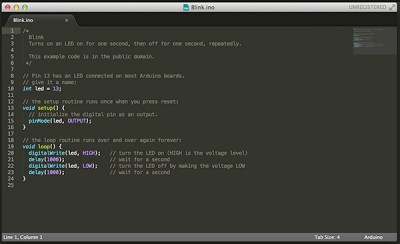

A lot of Arduino users with a software development background are switching to Sublime Text + Stino, and I believe it would be natural to do the same regarding Processing IDE, even more if you are now able to replace java with Python. The problem is: both Arduino and Processing default editors are unacceptably featureless, compared to Sublime Text. Para MacOS, la licencia se encuentra en /Applications/Sublime Text 2.app/Contents/MacOS/For Linux it’s here /usr/lib/sublime-text-2Note for Linux users- If you’ve registered your copy of Sublime Text, but every time you open it you’re asked to enter your license, you should try running this command.
SUBLIME TEXT ARDUINO ANDROID
files and generates, things like the boards list, the list of board types, which you then select. android api app arduino bot c c++ capstone capstone project code coding coding. It also reads in the Arduino platform.txt, boards.txt. It even loads a lot of included examples written in Python, and everything works right out of the box. One of the nice things about the Stino setup, is they create a Arduino Menu on the top of sublime text, which already has commands built into build/compile. Now I am quite interested in learning the Processing toolchain so that I can make Processing + Arduino projects, and I gladly discovered that Processing now supports "Python mode", that is, goodbye Java (yay!). Syntax highlighting for some languages that are not officially supported by Sublime Text - syntax-for-sublime-text/arduino. It also comes ready with pre-installed and configured file icons to make your Sublime Text editor aesthetically easier to use. Afterglow is a dark theme that utilizes a white, orange, and green palette.

This plugin creates a new "Arduino" menu entry in Sublime Text, so that every command on the default Arduino IDE (and some more) is made available from inside Sublime Text, while under the hood the actual Arduino tools are called from inside the Arduino IDE application folder. Stino is a Sublime Text plugin that provides an Arduino -like environment for editing, compiling and uploading sketches. This is an interesting choice and makes an impacting alternative light theme with a retro vibe. Is it simple/worth it to get sublime integrated with Arduino, or should I keep doing what I have been doing: (1) Editing code in Sublime (2) Compile/upload from Arduino IDE. I am happily using Sublime Text instead of the default Arduino IDE to work with Arduino (.ino) files, thanks to the wonderful Stino plugin. Hi all - as a software developer I use Sublime text on Windows as my main editor.


 0 kommentar(er)
0 kommentar(er)
